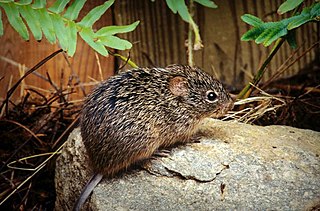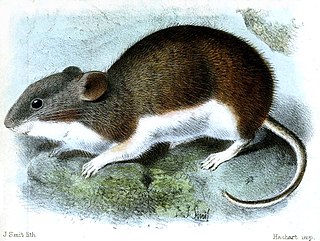
The rodent subfamily Sigmodontinae includes New World rats and mice, with at least 376 species. Many authorities include the Neotominae and Tylomyinae as part of a larger definition of Sigmodontinae. When those genera are included, the species count numbers at least 508. Their distribution includes much of the New World, but the genera are predominantly South American, such as brucies. They invaded South America from Central America as part of the Great American Interchange near the end of the Miocene, about 5 million years ago. Sigmodontines proceeded to diversify explosively in the formerly isolated continent. They inhabit many of the same ecological niches that the Murinae occupy in the Old World.
The big-eared hopping mouse is an extinct species of mouse, which lived in the Moore River area of south-western Australia. The big-eared hopping mouse was a small, rat-sized animal resembling a tiny kangaroo. It had large eyes and ears with a brush-tipped tail. It moved on its four legs when traveling at a slower pace, or by bounding upon its enlarged, padded, hind feet when traveling quickly. They mainly lived in sand dunes and made nests of leaves and other organic materials. The big-eared hopping-mouse was last collected in July 1843 near the Moore River, Western Australia, close to where New Norcia is now situated, and has not been seen since.

The gray leaf-eared mouse is a rodent species from South America. It is found in Argentina, Bolivia, Brazil and Paraguay; its habitat includes the Gran Chaco.

The greater mouse-eared bat is a European species of bat in the family Vespertilionidae.

The Bolivian big-eared mouse is a species of rodent in the family Muridae. It is found in Bolivia, Chile, and Peru.

The southern big-eared mouse, also known as the southern pericote, is a species of rodent in the family Cricetidae. It is found in Argentina and Chile, and is one of only two species in its genus. The type specimen was captured by Charles Darwin in 1834 along the Santa Cruz River in Argentina, during the voyage of HMS Beagle, and was subsequently described by George Robert Waterhouse.

The painted big-eared mouse is a species of rodent in the family Cricetidae. It is found in Bolivia and Peru, and possibly Chile.
The Andean big-eared mouse is a species of rodent in the family Cricetidae. It is found in Argentina, Bolivia, Chile, and Peru.
Graomys is a genus of rodent in the family Cricetidae. It contains the following species:
The gerbil mouse or long-eared mouse is a species of rodent in the family Nesomyidae. It is found in Angola, Botswana, Namibia, and South Africa. Its natural habitats are dry savanna, subtropical or tropical dry shrubland, hot deserts, and temperate deserts.

Phyllotis is a genus of rodent in the family Cricetidae. These mice are commonly confused with Auliscomys, Graomys and Loxodontomys.. In order to tell these genera apart, one must look at the tail. Species in the genus Phyllotis have a penicillate tip on their tail which is not present in the other two genera. Tails in the genus Phyllotis are also less than the length of its head and body combined whereas in Graomys, tails are longer than the head and body combined. Phyllotis xanthopygus was found at the summit of Volcán Llullaillaco, which is the highest altitude a mammal has yet been found in nature.

The Didelphinae are a subfamily of opossums consisting of 15 genera and 123 species. Specimens have been collected throughout the Americas, but are predominant in South and Central America.

The big-eared woodrat is a nocturnal rodent of the woodrat genus Neotoma, in the family Cricetidae. Closely related to, and formerly included in the species Neotoma fuscipes, it is endemic to western North America and occurs west and south of the Salinas Valley from the California Coast Ranges south of Monterey Bay to northern Baja California, as well as in the Sierra Nevada, extending north to the South Fork American River.

Loxodontomys is a genus of South American rodents in the tribe Phyllotini of family Cricetidae. Two species are known, found in Argentina and Chile. They are as follows:









